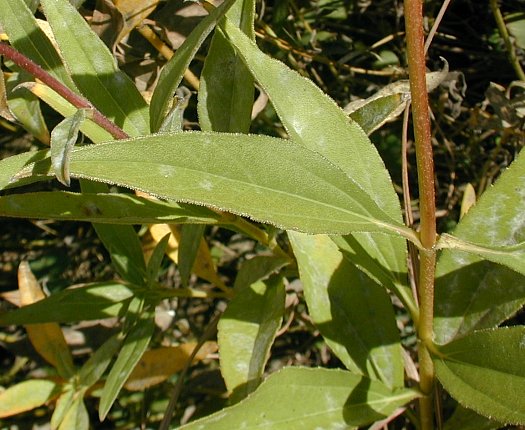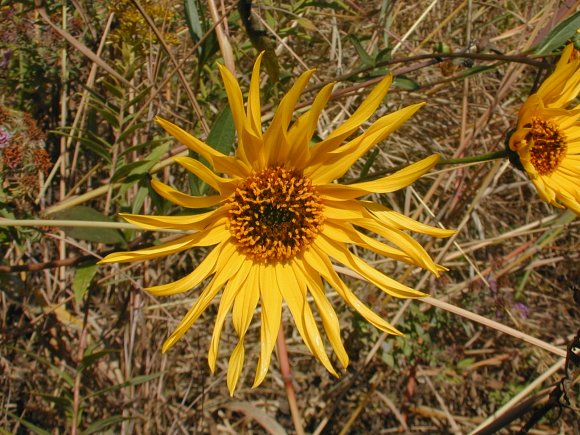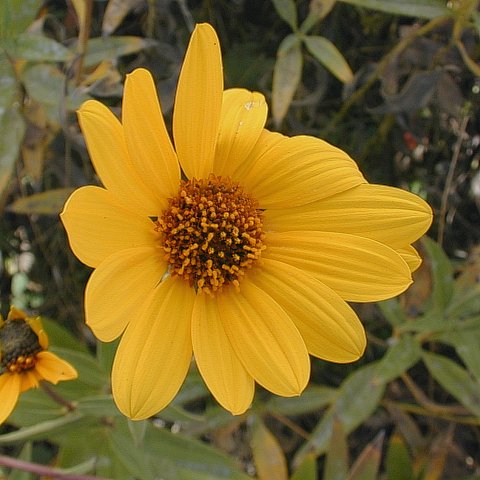Description: This herbaceous perennial plant is 2-4' tall. It is either unbranched or sparingly branched toward the apex. The central stem is green or reddish brown; it has scattered short white hairs that are quite stiff, providing a sand-papery texture. The opposite leaves are up to 6" long and 2" across, becoming slightly smaller and more narrow as they ascend the stem. However, one or two of the uppermost leaves may alternate along the stem. These leaves are lanceolate or narrowly ovate, tapering gradually at the base. They have short thick petioles, smooth or slightly serrate margins, and a rather rough texture because of scattered short stiff hairs and fine bumps on the surface. In hot dry weather, the leaves often curl upward along the central vein.
Each composite flower is about 2½–3" across, occurring individually at the apex of the central stem and any upper lateral stems. It consists of 10-25 yellow ray florets surrounding numerous reddish brown or yellow disk florets (the latter is atypical). Sometimes the ray florets fold along their length and assume a star-like quality in response to hot dry weather. The floral bracts (phyllaries) surrounding the base of each composite flower are triangular in shape and appressed together in 2-3 overlapping series. There is little noticeable floral scent. The blooming period occurs from late summer to fall, lasting 1-2 months. The root system produces numerous rhizomes, which enables this plant to form dense colonies quickly. These colonies of Prairie Sunflower tend to exclude other plant species because the roots exude allelopathic chemicals that inhibit seed germination and growth of young plants. Because Prairie Sunflower is somewhat vulnerable to these chemicals itself, the plants in the middle of a colony sometimes die out, creating a "fairy ring" effect.

Cultivation:
The preference is full sun and mesic to dry conditions. The soil can
contain significant amounts of loam, clay loam, sand, or gravelly
material. This plant is easy to grow, but can spread and become very
aggressive. Patches of powdery mildew may occur on the leaves. It is
sometimes shy to flower.
Range & Habitat:
The native Prairie Sunflower occurs occasionally in central and
northern Illinois,
but is uncommon or absent in many areas of southern Illinois (see Distribution
Map). It is locally common in some prairie remnants,
particularly along railroads. Habitats include mesic to dry black soil
prairies, gravel prairies, sand prairies, hill prairies, limestone
glades, and areas along railroads.

Faunal Associations: The flowers attract bumblebees, Miner bees, large Leaf-Cutting bees, Halictine bees, bee flies, butterflies, and skippers. Typical butterfly visitors include Phyciodes tharos (Pearl Crescent), Vanessa cardui (Painted Lady), and Chlosyne spp. (Checkerspot butterflies). These insects seek nectar, although the bees also collect pollen. The caterpillars of the butterflies Chlosyne nycteis (Silvery Checkerspot), Chlosyne gorgone (Gorgon Checkerspot), and Vanessa cardui (Painted Lady) feed on the foliage of this and other sunflowers. The larvae of several species of moths and miscellaneous other insects feed on various parts of sunflowers (see Insect Table). Insects that have been observed to feed on Prairie Sunflower (Helianthus pauciflorus) specifically include Trirhabda adela (Skeletonizing Leaf Beetle sp.), Zygogramma exclamationis (Sunflower Beetle), Cylindrocopturus adspersus (Sunflower Stem Weevil), Smicronyx fulvus (Red Sunflower Seed Weevil), larvae of Neotephritis finalis (Sunflower Seed Maggot), larvae of Cochylis hospes (Banded Sunflower Moth), Hesperotettix speciosus (Western Grass-green Grasshopper), and other grasshoppers. The large and nutritious seeds are eaten by many kinds of upland gamebirds and songbirds (see Bird Table). Mammals that eat the seeds and/or other parts of sunflowers include the Franklin Ground Squirrel, Thirteen-lined Ground Squirrel, Plains Pocket Gopher, Prairie Vole, Meadow Vole, White-tailed Rabbit, White-tailed Deer, and domesticated livestock.

Photographic
Location: The photographs were taken at Dave
Monk's postage stamp prairie in Champaign, Illinois.
Comments:
Prairie Sunflower can be variable in appearance. With respect to the
flowers, the disk florets are usually reddish brown (maroon), however
sometimes they are yellow in appearance; there are usually 10-15 ray
florets, but sometimes as many as 25. Similarly, the leaves are often
1" across or less, but sometimes wider. These variations may
be the result of hybridization, or the existence of subspecies that
remain to be identified. This sunflower species can be distinguished
from others by the rough texture of its leaves and stems, the short
stout petioles, and the lanceolate shape of its leaves. In
addition, the floral bracts (phyllaries) are triangular in
shape and more wide than those of most other
sunflowers. Prairie Sunflower is more xerophytic than many
other sunflowers in Illinois, favoring dry upland areas in full
sunlight. Another scientific name for this plant is Helianthus
rigidus, but it is considered obsolete.
